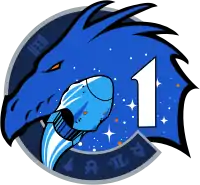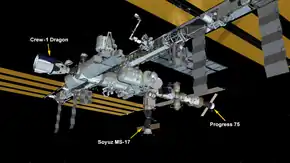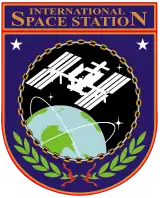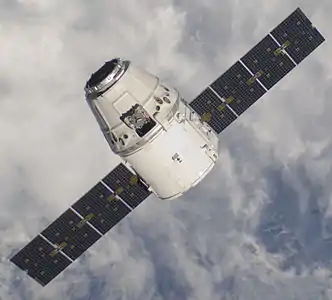SpaceX Crew-1
SpaceX Crew-1 [3][4] (also known as USCV-1 or simply Crew-1) [5] is the first operational[lower-alpha 1] crewed flight of a Crew Dragon spacecraft. It is also the first crewed night launch by the United States since that of STS-131 in April 2010. The Crew Dragon spacecraft Resilience launched on 16 November 2020 at 00:27:17 UTC [6][lower-alpha 2] on a Falcon 9 from the Kennedy Space Center, LC-39A, carrying NASA astronauts Michael Hopkins, Victor Glover and Shannon Walker along with JAXA astronaut Soichi Noguchi, all members of the Expedition 64 crew.[7] The mission is the second overall crewed orbital flight of the Crew Dragon.[9]
.jpg.webp) | |
| Names | USCV-1 Crew-1 |
|---|---|
| Mission type | ISS crew transport |
| Operator | SpaceX |
| COSPAR ID | 2020-084A |
| SATCAT no. | 46920 |
| Mission duration | 82 days (in progress) ~180 days (planned) |
| Spacecraft properties | |
| Spacecraft | Cargo Dragon C207 Resilience |
| Manufacturer | SpaceX |
| Crew | |
| Crew size | 4 |
| Members | |
| Expedition | Expedition 64 |
| Start of mission | |
| Launch date | 16 November 2020, 00:27:17 UTC [1] |
| Rocket | Falcon 9 Block 5 B1061.1 |
| Launch site | KSC, LC-39A |
| Contractor | SpaceX |
| End of mission | |
| Landing date | Late April or early May 2021 (planned) |
| Landing site | Atlantic Ocean |
| Orbital parameters | |
| Reference system | Geocentric orbit |
| Regime | Low Earth orbit |
| Inclination | 51.66° |
| Docking with ISS | |
| Docking port | Harmony Forward |
| Docking date | 17 November 2020, 04:01 UTC [2] |
| Undocking date | May 2021 (planned) |
| Time docked | 81 days (in progress) ~180 days (planned) |
 SpaceX Crew-1 patch  (l-r) Walker, Glover, Hopkins and Noguchi | |
Crew-1 is the first operational mission to the International Space Station in the Commercial Crew Program. Originally designated "USCV-1" by NASA in 2012, the launch date was delayed several times from the original date of November 2016.[10] The mission is expected to return to Earth in late April or early May 2021.[3] [11] Resilience is expected to return to Earth via splashdown for reuse for another future mission.[12]
Background
The first operational mission in the Commercial Crew Program, originally designated "USCV-1" (United States Crew Vehicle, mission 1) by NASA, was initially announced in November 2012, with a launch date set for November 2016.[10] In April 2013, it was announced that the launch would be delayed by one year to November 2017.[10] It was then delayed into 2019 and 2020, pending the success of the uncrewed and crewed demonstration missions, respectively. Following the Crew Dragon Demonstration Mission 2, Crew-1 was tentatively scheduled for September 2020; further delays occurred to align with the ongoing COVID-19 pandemic restrictions and their impact on the schedule of ISS crew rotations and cargo delivery missions,[12] and then again because of concerns about an issue with the gas generators on the Merlin 1D engines.[13]
On 29 September 2020, mission commander Michael Hopkins revealed during a NASA press conference that the capsule's crew had chosen to name it Resilience.[14]
Due to the COVID-19 pandemic in Florida, the Kennedy Space Center Visitor Complex only allowed a few people to watch the launch in person from the KSC premises.[15]
Crew
NASA astronauts Michael S. Hopkins and Victor J. Glover were announced as the crew on 3 August 2018.[16] JAXA astronaut Soichi Noguchi and the third NASA astronaut, Shannon Walker, were added on 31 March 2020 to the crew.[17][18][19]
| Position | Astronaut | |
|---|---|---|
| Spacecraft commander | Expedition 64 Second spaceflight | |
| Pilot | Expedition 64 First spaceflight | |
| Mission Specialist 1 | Expedition 64 Third spaceflight | |
| Mission Specialist 2 | Expedition 64 Second spaceflight | |
| Position | Astronaut | |
|---|---|---|
| Spacecraft commander | ||
| Mission Specialist 1 | ||
Preparations
The Falcon 9 for the Crew-1 mission arrived at Cape Canaveral, Florida, on 14 July 2020.[20] Crew Dragon capsule C207 arrived at SpaceX processing facilities in Florida, on 18 August 2020.[21][22] The successful launch of the Falcon 9 launch vehicle from Cape Canaveral Air Force Station (CCAFS) on 5 November 2020 was a milestone leading up to the Crew-1 mission. Falcon 9 successfully deployed a GPS navigation satellite (GPS III-04) for the United States Space Force (USSF), confirming that engineers have resolved an issue with Merlin 1D engines that delayed the GPS mission and the Crew-1 flight.[23]
The crew arrived at Kennedy Space Center via a NASA Gulfstream jet on 8 November 2020 at 13:53 UTC. A Flight Readiness Review (FRR) convened by NASA officials was scheduled on 10 November 2020 to discuss unresolved technical issues, review the status of launch preparations, and give approval for teams to proceed with the Crew-1 mission.[23] NASA officials gave approval on 12 November 2020 for SpaceX to begin regular crew rotation flights to the International Space Station (ISS), signaling a transition from development to operations for the human-rated Crew Dragon spacecraft.[24] The launch vehicle was lifted to its vertical position at the pad for a test firing of its Merlin-1D main engines on 11 November 2020 at 20:49 UTC.[25] A dry dress rehearsal (DDR) on 12 November 2020 saw the crew put on their pressure suits and climb into Resilience.[25] SpaceX ran a launch readiness review (LRR) on 13 November 2020.[26]
Mission

.jpg.webp)

On 15 November 2020, final pre-launch preparations were completed. The hatch of Crew Dragon Resilience was closed at 22:32 UTC, but was reopened briefly after a slight drop in pressure was noted. Troubleshooting around the hatch seal led to discovery of a small amount of foreign object debris (FOD) in the seal. The hatch was then closed afterward, and mission controllers proceeded with the countdown. No further concerns were noted, and on 16 November 2020 at 00:27:17 UTC, Resilience lifted off successfully. Its Falcon 9 first-stage booster, SN B1061.1, landed on the autonomous spaceport drone ship Just Read the Instructions.[6] The astronauts entered a stable orbit after about nine minutes. For this mission, the crew had chosen a plush toy of The Child (Grogu), Baby Yoda, from The Mandalorian as Zero-G indicator.[27] The crew were awakened on the second day of the flight with Phil Collins's "In the Air Tonight".[28]
Resilience docked to the International Docking Adapter (IDA) on the Harmony module on 17 November 2020 at 04:01 UTC.[2] Over the course of the mission, the four astronauts will live and work alongside the three astronauts of the Soyuz MS-17 mission. Together, the two missions will form ISS Expedition 64. Assuming the regular ISS crew rotation schedule is adhered to, the crew will transfer to Expedition 65 following the departure of Soyuz MS-17, currently scheduled for April 2021.
Timeline
| MET | Time (EST) | Time (UTC) | Date (UTC) | Event [29] |
|---|---|---|---|---|
| −7:40:00 | 11:47:15 AM | 16:47:15 | 15 November 2020 |
Crew wake |
| −05:30:00 | 1:57:15 PM | 18:57:15 | CE (signification?) launch readiness briefing | |
| −05:00:00 | 2:27:15 PM | 19:27:15 | Launch shift on console | |
| −04:59:59 | 2:27:16 PM | 19:27:16 | Dragon IMU align and configure for launch. | |
| −04:30:00 | 2:57:15 PM | 19:57:15 | Dragon propellant pressurization | |
| −04:15:00 | 3:12:15 PM | 20:12:15 | Crew weather brief | |
| −04:05:00 | 3:22:15 PM | 20:22:15 | Crew handoff | |
| −04:00:00 | 3:27:15 PM | 20:27:15 | Suit donning and checkouts | |
| −03:22:00 | 4:05:15 PM | 21:05:15 | Crew walk out of Neil Armstrong Operations and Checkout Building | |
| −03:15:00 | 4:12:15 PM | 21:12:15 | Crew transportation to Launch Complex 39A (LC-39A) | |
| −02:55:00 | 4:32:15 PM | 21:32:15 | Crew arrives at pad. | |
| −02:35:00 | 4:52:15 PM | 21:52:15 | Crew ingress | |
| −02:20:00 | 5:07:15 PM | 22:07:15 | Communication check | |
| −02:15:00 | 5:12:15 PM | 22:12:15 | Verify ready seat rotation | |
| −02:14:00 | 5:13:15 PM | 22:13:15 | Suit leak checks | |
| −01:55:00 | 5:32:15 PM | 22:32:15 | Hatch close | |
| −01:10:00 | 6:17:15 PM | 23:17:15 | ISS state upload to Dragon | |
| −00:45:00 | 6:42:15 PM | 23:42:15 | SpaceX launch director verifies go for propellant load | |
| −00:42:00 | 6:45:15 PM | 23:45:15 | Crew access arm retracts | |
| −00:37:00 | 6:49:15 PM | 23:49:15 | Dragon launch escape system is armed. | |
| −00:35:00 | 6:52:15 PM | 23:52:15 | RP-1 (rocket grade kerosene) loading begins; 1st stage LOX (liquid oxygen) loading begins. | |
| −00:16:00 | 7:11:15 PM | 00:11:15 | 16 November 2020 |
2nd stage LOX loading begins. |
| −00:07:00 | 7:20:15 PM | 00:20:15 | Falcon 9 begins engine chill prior to launch. | |
| −00:05:00 | 7:22:15 PM | 00:22:15 | Dragon transitions to internal power | |
| −00:01:00 | 7:26:15 PM | 00:26:15 | Command flight computer to begin final prelaunch checks; propellant tank pressurization to flight pressure begins. | |
| −00:00:45 | 7:26:30 PM | 00:26:30 | SpaceX launch director verifies go for launch. | |
| −00:00:03 | 7:27:12 PM | 00:27:12 | Engine controller commands engine ignition sequence to start. | |
| +00:00:00 | 7:27:17 PM | 00:27:17 | Liftoff | |
| +00:00:58 | 7:28:15 PM | 00:28:15 | Max Q (moment of peak mechanical stress on the rocket) | |
| +00:02:37 | 7:29:54 PM | 00:29:54 | 1st stage main engine cutoff (MECO) | |
| +00:02:40 | 7:29:57 PM | 00:29:57 | 1st and 2nd stages separate | |
| +00:02:48 | 7:30:05 PM | 00:30:05 | 2nd stage engine starts | |
| +00:07:29 | 7:34:46 PM | 00:34:46 | 1st stage entry burn | |
| +00:08:50 | 7:36:07 PM | 00:36:07 | 2nd stage engine cutoff (SECO-1) | |
| +00:08:59 | 7:36:16 PM | 00:36:16 | 1st stage landing burn | |
| +00:09:29 | 7:36:46 PM | 00:36:46 | 1st stage landing | |
| +00:12:03 | 7:39:20 PM | 00:39:20 | Crew Dragon separates from 2nd stage | |
| +00:12:48 | 7:40:05 PM | 00:40:05 | Dragon nosecone open sequence begins | |
| +1/ | 9:22 PM | 02:22 | 17 November 2020 |
Dragon starts the final phase of the approach to the ISS.[30] |
| +1/03:33 | 11:01 PM | 04:01 | Soft Capture to the ISS.[31] | |
| +1/03:33 | 11:01 PM | 04:01 | Dragon docked to the ISS.[32] | |
| +1/05:34 | 1:02 AM | 6:02 | Hatch opened.[33] |
See also
| Wikimedia Commons has media related to SpaceX Crew-1. |
- Resilience
- Boeing CST-100 Starliner
- SpaceX Dragon 2
- Crew Dragon Demo-2
Notes
- The Crew Dragon Demo-2 mission was the first crewed flight, but was considered a test flight, not an operational flight
- 15 November 2020 19:27 Eastern Standard Time (EST), 16 November 2020 00:27 UTC
References
- "Astronauts fly with SpaceX in landmark launch for commercial spaceflight". Spaceflight Now. 16 November 2020. Retrieved 18 November 2020.
- Burghardt, Thomas (17 November 2020). "Crew Dragon Resilience successfully docks, expands ISS crew to seven". NASASpaceFlight.com.
- NASA (25 May 2020). "CCP - Press Kit". Commercial Crew Program. NASA. Archived from the original on 25 May 2020. Retrieved 3 June 2020.
The Crew; Victor Glover SpaceX Crew-1; Mike Hopkins SpaceX Crew-1; Soichi Noguchi SpaceX Crew-1; Shannon Walker SpaceX Crew-1
 This article incorporates text from this source, which is in the public domain.
This article incorporates text from this source, which is in the public domain. - Shireman, Kirk (14 May 2020). "HEO NAC May 2020 International Space Station Status" (PDF). nasa.gov. Archived (PDF) from the original on 3 June 2020. Retrieved 3 June 2020.
Fall 2020 – SpaceX Crew-1 Launch and Dock [...] Demo2 in May/2020, Crew-1 in Fall/2020
 This article incorporates text from this source, which is in the public domain.
This article incorporates text from this source, which is in the public domain. - Glover, Victor [@VicGlover] (12 April 2019). "1st crewed Dragon Mission=DM-2 or Demo-2. 2nd crewed Dragon Mission (and 1st long duration ISS Mission)=Crew-1 or Crew One" (Tweet). Retrieved 26 May 2020 – via Twitter.
 This article incorporates text from this source, which is in the public domain.
This article incorporates text from this source, which is in the public domain. - Corbett, Tobias; Barker, Nathan (15 November 2020). "With Resilience, NASA and SpaceX begin operational Commercial Crew flights". NASASpaceFlight.com.
- Heiney, Anna (14 August 2020). "NASA, SpaceX Targeting October for Next Astronaut Launch". blogs.nasa.gov. Retrieved 27 August 2020.
 This article incorporates text from this source, which is in the public domain.
This article incorporates text from this source, which is in the public domain. - "DM2 CCP Press Kit 2020". Commercial Crew Program. NASA. 24 March 2020. Retrieved 10 May 2020.
 This article incorporates text from this source, which is in the public domain.
This article incorporates text from this source, which is in the public domain. - Bergin, Chris (6 April 2013). "USCV-1: NASA planners slip first ISS commercial crew mission to late 2017". NASASpaceFlight.com. Retrieved 24 April 2020.
- Heiney, Anna. "NASA, SpaceX to Launch Second Commercial Crew Rotation Mission to International Space Station". nasa.gov. NASA. Retrieved 29 January 2021.
 This article incorporates text from this source, which is in the public domain.
This article incorporates text from this source, which is in the public domain. - "Launch Schedule". Spaceflight Now. 23 October 2020. Retrieved 24 October 2020.
- "NASA, SpaceX Crew-1 Launch Update". Commercial Crew Program. NASA. Retrieved 10 October 2020.
 This article incorporates text from this source, which is in the public domain.
This article incorporates text from this source, which is in the public domain. - Gebhardt, Chris [@ChrisG_NSF] (29 September 2020). "Crew-1 has named their Dragon spacecraft. Welcome to the family, Dragon #Resilience" (Tweet) – via Twitter.
- "NASA urges COVID caution for spectators of SpaceX Crew-1 astronaut launch". space.com. Space.com. Retrieved 15 November 2020.
- Lewis, Marie (3 August 2018). "Meet the Astronauts Flying SpaceX's Demo-2". NASA. Retrieved 3 March 2019.
 This article incorporates text from this source, which is in the public domain.
This article incorporates text from this source, which is in the public domain. - Clark, Stephen (31 March 2020). "NASA, JAXA assign two more astronauts to second piloted Crew Dragon flight". Spaceflight Now. Retrieved 1 April 2020.
- Gagarin Research and Test Cosmonaut Training Center (18 March 2019). "Астронавты НАСА Майкл Хопкинс, Виктор Глоувер и Челл Линдгрен приступили к подготовке в ЦПК" [NASA astronauts Michael Hopkins, Victor Glover and Kjell Lindgren begin training at the GCTC] (in Russian). Yuri Gagarin Cosmonaut Training Center. Retrieved 26 May 2020.
- Powell, Joel [@ShuttleAlmanac] (19 November 2020). "JAXA has announced long stay visits to the ISS for 2022 and 2023" (Tweet) – via Twitter.
- Sempsrott, Danielle (16 July 2020). "Falcon 9 Rocket Arrives for NASA's SpaceX Crew-1 Mission". blogs.nasa.gov. Retrieved 18 July 2020.
 This article incorporates text from this source, which is in the public domain.
This article incorporates text from this source, which is in the public domain. - Groh, Jamie (23 August 2020). "SpaceX Crew Dragon capsule arrives in Florida for next NASA astronaut launch". Teslarati. Retrieved 24 August 2020.
- Sempsrott, Danielle (21 August 2020). "Preparations Continue for SpaceX First Operational Flight with Astronauts". blogs.nasa.gov. Retrieved 24 August 2020.
 This article incorporates text from this source, which is in the public domain.
This article incorporates text from this source, which is in the public domain. - "Crew Dragon "Resilience" meets Falcon 9 rocket at Florida spaceport". Spaceflight Now. 6 November 2020. Retrieved 7 November 2020.
- "NASA formally certifies SpaceX's Crew Dragon for "operational" astronaut flights". Spaceflight Now. 10 November 2020. Retrieved 11 November 2020.
- "Falcon 9 rocket fires up in crucial test before weekend crew launch". Spaceflight Now. 11 November 2020. Retrieved 12 November 2020.
- "Crew launch delayed to Sunday". Spaceflight Now. 13 November 2020. Retrieved 13 November 2020.
- "Baby Yoda joins astronauts on SpaceX's Crew Dragon launch as its zero G indicator". The Washington Post. 16 November 2020.
- "Mission Timeline for Launch Sunday, November 15 at 19:27:15 EST" (PDF). NASA.
 This article incorporates text from this source, which is in the public domain.
This article incorporates text from this source, which is in the public domain. - Garcia, Mark (16 November 2020). "SpaceX Crew-1 Astronauts Approaching Station". blogs.nasa. Retrieved 13 December 2020.
 This article incorporates text from this source, which is in the public domain.
This article incorporates text from this source, which is in the public domain. - "SpaceX's Crew-1 astronaut launch for NASA: Live updates". Space.com. Retrieved 13 December 2020.
- Cawley, James (17 November 2020). "Crew Dragon Docks to Station, Hatches Open Soon". blogs.nasa. Retrieved 13 December 2020.
 This article incorporates text from this source, which is in the public domain.
This article incorporates text from this source, which is in the public domain. - Cawley, James (17 November 2020). "Hatches Open, Crew Dragon Astronauts Join Expedition 64". blogs.nasa. Retrieved 13 December 2020.
 This article incorporates text from this source, which is in the public domain.
This article incorporates text from this source, which is in the public domain.



.jpg.webp)
